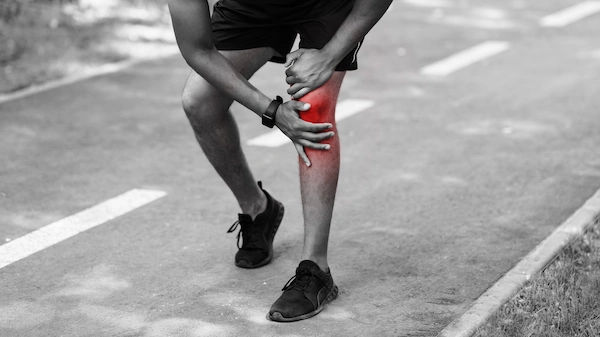Guide to Robotic Knee Hip Replacement
Explore the future of joint replacement with our comprehensive guide to robotic knee and hip surgery. Learn about the technology, benefits, recovery process, and what to expect from this advanced procedure for a more precise and personalized outcome.

Written by Dr. Mohammed Kamran
Reviewed by Dr. Dhankecha Mayank Dineshbhai MBBS
Last updated on 25th Sep, 2025

Introduction
Chronic knee or hip pain can feel like a life sentence, limiting your ability to enjoy simple pleasures. If you’ve exhausted conservative treatments and are considering joint replacement, you’ve likely heard about a revolutionary approach: robotic surgery. But what does it really mean? Is it science fiction or a tangible improvement in orthopedic care? This guide cuts through the hype to give you a clear, comprehensive understanding of robotic knee and hip replacement. We will explore how this technology works, its significant benefits for recovery and outcomes, and how it empowers surgeons with unprecedented precision. Whether you're just starting your research or are close to making a decision, this article will provide the insights you need to have an informed conversation with your doctor about the best path forward for a pain-free, active life.
What is Robotic Joint Replacement? It’s Not What You Think.
When people hear "robot surgery," they often imagine a machine operating autonomously. In reality, robotic-assisted joint replacement is an advanced surgical tool that enhances a surgeon’s skill; it does not replace it. Think of it like a high-tech GPS for your car. The GPS provides detailed maps, suggests the optimal route, and warns you if you’re drifting out of your lane, but you, the driver, remain in full control of the vehicle. Similarly, the robotic system gives your surgeon a detailed, personalized plan and real-time feedback to execute the surgery with exceptional accuracy.
The Surgeon is Still in Command: Debunking the "Robot Surgery" Myth
The core principle of this technology is surgeon control. The robotic arm is guided by the surgeon’s hands at every moment. It is equipped with sophisticated safety features that can create a "virtual boundary" around the surgical area. This means the robot can help prevent the surgeon from accidentally removing too much bone or placing the implant outside the pre-defined optimal zone. This enhanced control is a significant factor in achieving better surgical outcomes and is a key reason why many patients experience a more natural feeling in their new joint.
A Brief History: The Evolution of Surgical Precision
Orthopedic surgery has evolved from relying solely on a surgeon’s experience and mechanical guides to incorporating computer navigation and now, robotic assistance. Systems like the MAKO robotic arm have been used in over one million procedures worldwide, providing a wealth of data that continues to refine the process. This evolution represents a shift towards truly personalized medicine, where each patient’s unique anatomy dictates the surgical plan, leading to more predictable and successful results.
Consult Top Specialists
How Robotic Assistance Transforms Knee and Hip Surgery?
The power of robotic surgery lies in its three-phase approach: planning, guidance, and execution. This structured process ensures that every step is tailored specifically to you.
Phase 1: The Virtual Blueprint – Advanced 3D Pre-Operative Planning
Before you even enter the operating room, your surgeon creates a detailed, 3D virtual model of your joint using a CT scan. This is a cornerstone of patient-specific planning. On this digital model, your surgeon can precisely plan the surgery: determining the exact size, position, and alignment of the implant based on your unique bone structure, ligament balance, and anatomy. This is a stark contrast to traditional surgery, where much of the decision-making happens during the operation itself.
Phase 2: In-the-Moment Guidance – Enhanced Accuracy During Surgery
During the procedure, the system tracks the position of your bones and the surgical instruments in real-time. As your surgeon prepares the bone for the implant, the system provides instant feedback on a screen, showing the progress against the pre-operative plan. This in-the-moment guidance allows for adjustments to be made with sub-millimeter accuracy, ensuring the plan is followed perfectly.
Phase 3: The Finishing Touch – Precise Implant Positioning
The ultimate goal is to position the new joint implant optimally. Studies have shown that even a few degrees of deviation in implant placement can lead to uneven wear, instability, and a less natural feel. The robotic system’s precision helps ensure the implant is placed as planned, which is critical for the longevity of the new joint and your satisfaction after surgery.
Robotic Knee Replacement: A New Level of Customization
For knees damaged by arthritis, the goal of replacement is to resurface the worn-out ends of the bones with smooth implants, restoring pain-free motion. Robotic knee replacement excels in this by offering a level of customization previously unimaginable.
Addressing Complex Knee Arthritis with Personalized Alignment
Every person’s knee alignment is slightly different. Robotic systems allow surgeons to plan for either a mechanically aligned knee or a more personalized "kinematic" alignment that aims to restore the knee’s natural, pre-arthritic state. This personalized approach can lead to a knee that feels more "like your own," potentially improving your gait and overall function after surgery.
The MAKO System: A Leader in Robotic Knee Surgery
One of the most widely used platforms is the Stryker MAKO robotic arm. For knee replacement, the system allows the surgeon to balance the soft tissues (ligaments) around the knee with exceptional precision. By providing real-time data on ligament tension, the surgeon can make fine adjustments to ensure the knee is stable throughout its range of motion, which is a key predictor of patient satisfaction.
Robotic Hip Replacement: Minimizing Dislocation Risk and Improving Function
Hip replacement involves replacing the "ball" (femoral head) and "socket" (acetabulum) of the hip joint. The single most important technical factor in a successful hip replacement is the position of the new socket.
The Critical Role of Cup Positioning in Hip Replacement
If the new socket (acetabular cup) is positioned incorrectly, even by a small margin, it significantly increases the risk of dislocation—where the ball pops out of the socket. It can also lead to impingement (the bones hitting each other), accelerated wear, and an uneven leg length. Robotic hip replacement technology gives the surgeon real-time data on the angle and position of the cup, dramatically improving the accuracy of placement and thereby reducing the risk of these complications.
Achieving Optimal Leg Length and Offset
A common concern for patients is leg length discrepancy after surgery. The precision of robotic assistance helps the surgeon accurately match the length and offset (the distance the hip sits from the body) of the new joint to your natural anatomy. This helps ensure both legs are even and the muscles around the hip are functioning optimally, contributing to a more natural walking pattern and greater comfort.
Robotic vs. Traditional Joint Replacement: A Clear Comparison
So, how does this advanced technology stack up against the conventional, time-tested method?
| Feature | Traditional Joint Replacement | Robotic-Assisted Joint Replacement |
| Surgical Planning | Guided by 2D X-rays and surgeon’s experience. | Uses a 3D CT-based model tailored to the patient. |
| Precision | Depends on manual technique and mechanical tools. | Provides real-time feedback with sub-millimeter accuracy. |
| Customization | Standardized technique applied to most patients. | Personalized to match each patient’s unique anatomy. |
| Soft Tissue Balance | Evaluated manually during the procedure. | Measured with real-time data on ligament tension. |
| Incision Size | Can be minimally invasive. | Can also be minimally invasive. |
Is Robotic Surgery Right for Every Patient?
While the benefits are significant, robotic surgery may not be necessary or suitable for every case. In very severe deformities or complex revision surgeries, a surgeon’s experience and adaptability might take precedence. The decision is always made collaboratively between you and your orthopedic surgeon. If you are unsure about your candidacy, consulting a specialist who is proficient in both traditional and robotic techniques can provide clarity. You can book a physical visit to an expert orthopedic surgeon with Apollo24|7 to discuss your specific condition.
The Patient Journey: From Consultation to Full Recovery
Understanding the process can alleviate anxiety. Here’s what you can generally expect.
Step 1: The Consultation and Determining Candidacy
Your journey begins with a comprehensive evaluation. Your surgeon will review your medical history, conduct a physical exam, and assess X-rays. If you are a candidate for joint replacement, you will discuss the options, including robotic assistance.
Step 2: Pre-Surgical Planning and the CT Scan
If you proceed with a robotic approach, you will have a CT scan of your joint. This scan is used to create the 3D model for the surgical plan. You will also undergo pre-operative tests (e.g., blood work, ECG) to ensure you are fit for surgery. Apollo24|7 offers convenient home collection for these pre-surgical tests, making preparation easier.
Step 3: Surgery Day and Hospital Stay
The surgery itself typically takes one to two hours. You will be under anesthesia, and your surgeon will use the robotic system to perform the procedure as planned. Hospital stays are often short, sometimes just one or two nights, depending on your progress.
Step 4: The Road to Recovery: What to Expect
Recovery time for robotic joint replacement is often accelerated due to the minimally invasive nature and precision of the surgery, which can lead to less tissue trauma. You will begin physical therapy almost immediately. While full recovery takes months, many patients report less pain and a quicker return to daily activities in the early weeks compared to traditional surgery.
Addressing Common Concerns: Safety, Cost, and Finding a Surgeon
Is Robotic Surgery Safe? Understanding the Risks and Protocols
Robotic-assisted surgery is FDA-approved and has an excellent safety profile. The risks are similar to those of traditional joint replacement (e.g., infection, blood clots) but with the added benefit of potentially reducing risks related to implant malposition. The system’s built-in safety features provide an extra layer of protection.
Navigating the Cost and Insurance Landscape
The cost of robotic hip replacement or knee surgery can be higher due to the technology involved. However, many insurance companies, including Medicare, cover robotic-assisted procedures when deemed medically necessary, as they can lead to fewer complications and revision surgeries. It's crucial to verify coverage with your insurance provider and the hospital.
How to Choose a Qualified Robotic Joint Replacement Surgeon?
The technology is only as good as the surgeon using it. Look for an orthopedic surgeon who:
Is board-certified and fellowship-trained in joint replacement.
Has significant experience performing robotic-assisted procedures.
Can provide data on their personal outcomes.
Makes you feel comfortable and answers all your questions thoroughly.
The Future of Orthopedics: What’s Next for Robotic Assistance?
The field is rapidly advancing. We are moving towards even more integrated systems that incorporate artificial intelligence to predict optimal implant positioning based on vast datasets of successful outcomes. Augmented reality, where the surgeon sees digital overlays directly on the surgical field, is also on the horizon, promising to make an already precise process even more intuitive.
Consult Top Specialists
Conclusion: Empowering Your Decision for a Pain-Free Future
Choosing to undergo joint replacement is a significant decision. The advent of robotic knee and hip replacement technology offers a powerful option for those seeking the highest level of precision and personalization in their care. By providing your surgeon with advanced planning tools and real-time guidance, this approach aims to optimize your surgical outcome, enhance your recovery experience, and restore your mobility with a joint that feels natural and stable. Armed with this knowledge, you can confidently take the next step. Discuss these options with your family and your doctor to determine if a robotic-assisted path is the right route to reclaiming your active, pain-free life.
Consult Top Specialists

Dr Aakash Andgi
General Physician/ Internal Medicine Specialist
9 Years • MBBS MD
Bengaluru
Apollo Clinic, JP nagar, Bengaluru

Dr. Ashita Kuruvilla
General Physician/ Internal Medicine Specialist
7 Years • MBBS
Kolkata
KVC CLINIC, Kolkata

Dr Syed Mateen Pasha
General Physician
2 Years • MBBS
Bengaluru
PRESTIGE SHANTHINIKETAN - SOCIETY CLINIC, Bengaluru

Dr. Ashita Kuruvilla
General Physician/ Internal Medicine Specialist
7 Years • MBBS
East Midnapore
VIVEKANANDA SEBA SADAN, East Midnapore

Dr. Anand Ravi
General Physician
2 Years • MBBS
Bengaluru
PRESTIGE SHANTHINIKETAN - SOCIETY CLINIC, Bengaluru
More articles from Knee pain
Frequently Asked Questions
1. Does the robot perform the surgery on its own?
No. This is a critical misconception. The robotic system is a tool that is entirely controlled by your orthopedic surgeon. The surgeon guides the robotic arm throughout the entire procedure, using the system's feedback to execute their plan with enhanced precision.
2. What is the recovery time for robotic knee replacement?
While recovery varies by individual, many patients experience a faster initial recovery due to less soft tissue disruption. You may be walking the same day as surgery. A return to most daily activities can occur within 4-6 weeks, but full recovery and strength building can take 3-6 months or more, similar to traditional surgery but often with less pain in the early stages.
3. Is robotic joint replacement covered by insurance?
In most cases, yes. Major insurance providers, including Medicare, typically cover robotic-assisted surgery when it is deemed medically necessary. It is always best to confirm with your specific insurance plan and the healthcare facility beforehand to understand any out-of-pocket costs.
4. Are the implants used in robotic surgery different?
The implants themselves are the same FDA-approved prosthetics used in traditional surgery. The difference lies in the precision of the bone preparation and the positioning of the implant, which is customized to your anatomy.
5. What are the main risks of robotic hip surgery?
The risks are largely the same as traditional hip replacement, including infection, blood clots, and nerve injury. However, the precision of the robotic system may potentially lower the risk of specific complications like implant dislocation and leg length discrepancy

.webp)


